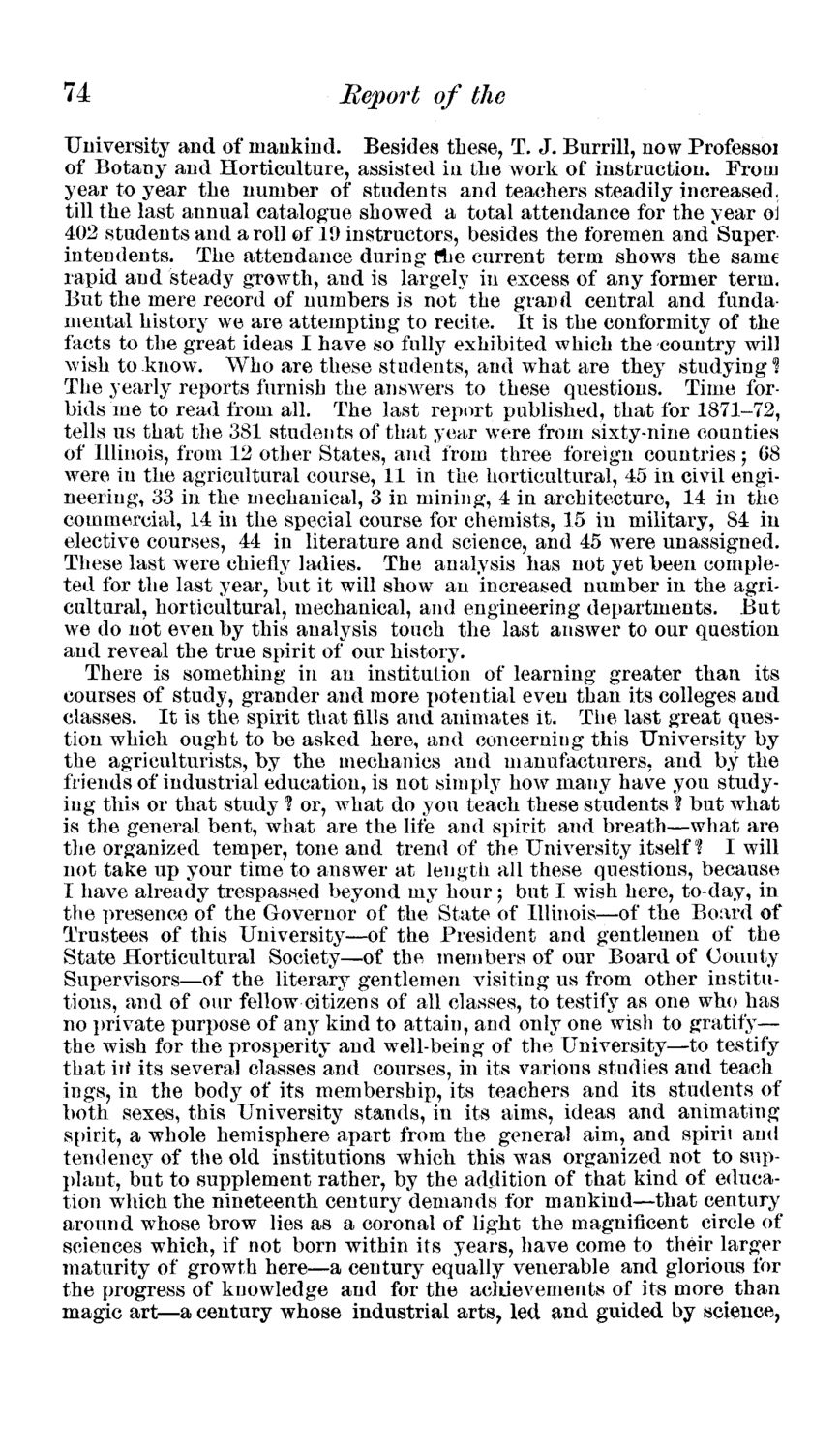| |
| |
Caption: Board of Trustees Minutes - 1874
This is a reduced-resolution page image for fast online browsing.

EXTRACTED TEXT FROM PAGE:
74 Report of the University and of mankind. Besides these, T. J. Burrill, now Professoi of Botany and Horticulture, assisted in the work of instruction. From year to year the number of students and teachers steadily increased, till the last annual catalogue showed a total attendance for the year o\ 402 students and a roll of 19 instructors, besides the foremen and Super in ten dents. The attendance during the current term shows the same rapid and steady growth, and is largely in excess of any former term. But the mere record of numbers is not the grand central and fundamental history we are attempting to recite. It is the conformity of the facts to the great ideas I have so fully exhibited which the country will wish to know. Who are these students, and what are they studying 1 The yearly reports furnish the answers to these questions. Time forbids me to read from all. The last report published, that for 1871-72, tells us that the 381 students of that year were from sixty-nine counties of Illinois, from 12 other States, and from three foreign countries; 68 were in the agricultural course, 11 in the horticultural, 45 in civil engineering, 33 in the mechanical, 3 in mining, 4 in architecture, 14 in the commercial, 14 in the special course for chemists, 15 in military, 84 in elective courses, 44 in literature and science, and 45 were unassigned. These last were chiefly ladies. The analysis has not yet been completed for the last year, but it will show an increased number in the agricultural, horticultural, mechanical, and engineering departments. But we do not even by this analysis touch the last answer to our question and reveal the true spirit of our history. There is something in an institution of learning greater than its courses of study, grander and more potential even than its colleges and classes. It is the spirit that fills and animates it. The last great question which ought to be asked here, and concerning this University by the agriculturists, by the mechanics and manufacturers, and by the friends of industrial education, is not simply how many have you studying this or that study ? or, what do you teach these students % but what is the general bent, what are the life and spirit and breath—what are the organized temper, tone and trend of the University itself? I will not take up your time to answer at length all these questions, because I have already trespassed beyond my hour; but I wish here, to-day, in the presence of the Governor of the State of Illinois—of the Board of Trustees of this University—of the President and gentlemen of the State Horticultural Society—of the members of our Board of County Supervisors—of the literary gentlemen visiting us from other institutions, and of our fellow citizens of all classes, to testify as one who has no private purpose of any kind to attaiu, and only one wish to gratify— the wish for the prosperity and well-being of the University—to testify that irf its several classes and courses, in its various studies and teach ings, in the body of its membership, its teachers and its students of both sexes, this University stands, in its aims, ideas and animating spirit, a whole hemisphere apart from the general aim, and spirit and tendency of the old institutions which this was organized not to supplant, but to supplement rather, by the addition of that kind of education which the nineteenth century demands for mankind—that century around whose brow lies as a coronal of light the magnificent circle of sciences which, if not born within its years, have come to their larger maturity of growth here—a century equally venerable and glorious for the progress of knowledge and for the achievements of its more than magic art—a century whose industrial arts, led and guided by science,
| |